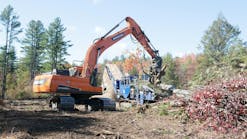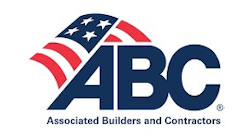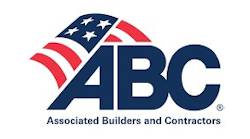There is no question of the value in using articulated trucks and hydraulic excavators for the major excavation work typically found on large site-preparation and road-building projects. But there also is plenty of serious work out there for the excavation and site-preparation contractor who owns a fleet of self-propelled scrapers. This is what the contractor Troy Abel of Abel Construction Company Inc. says.
He has 10 good reasons (10 scrapers, that is) for saying that many excavation and site-preparation projects are more cost-effective using scrapers than using articulated trucks with excavators. Abel, who is president of this company in Lancaster County, PA, says much of the company’s cut-and-fill work is carried out in ground conditions that range from high-quality, deep limestone soils once used for agricultural crop production to shallow soils with weathered and competent rock directly below. Most of the company’s projects are in south-central Pennsylvania and north-central Maryland. The company employees 130 people.A question that comes to mind is, can scrapers be used in soils which are rocky? The answer is yes, according to Larry Maney, site-work superintendent for the company. He is in charge of as many as five projects at any one time where the company’s scrapers are used, and many have rocky ground conditions. “We use scrapers all the time where there is rock to be excavated. The rock is drilled with very tight blast-hole patterns for getting good rock fragmentation. With the rock in small pieces, the scrapers can easily excavate it. For years we have been using scrapers this way with good results,” he explains.There are projects where articulated trucks and excavators are more cost-effective, says Maney. Those project conditions include irregular terrain or special profiling of the terrain that is not suitable for scrapers. Also, if the haul distances are long–that is, a mile or more from the excavation point to the dump point–the trucks are simply faster, thus affording superior production over scrapers. If the project calls for excavating much more ground than filling–necessitating hauling the excess off-site–articulated trucks are better because they stack the soil so the highway dump trucks can be loaded out with a front-end loader. To accommodate these projects, the company has a full-time crew with two 30-ton-payload-capacity Terex articulated trucks and a Kobelco excavator. As for the company’s scrapers, all are Terex. Abel own two S24 and eight TS14 model scrapers. The struck capacities of the bowls are 24 and 14 yd.3, respectively. “We own more 14s because they are more cost-effective to transport and operate at many of our projects. The S24 scrapers are used on projects where 200,000 cubic yards or more of earth must be cut,” explains Abel.Indeed, the transportation costs are relatively high for transporting an S24 scraper when compared to such costs associated with transporting a TS14 scraper. Because of its size, Abel has a commercial heavy-equipment transport company move the S24 scrapers. The cost for moving both to a project site and later hauling them away is $4,000-$5,000. For a 250,000-yd.3 excavating project, where the scraper transportation cost is spread over the total ground excavated, it comes to only 1.6—2 cents/yd.3 The cost spread over a 25,000-yd.3 project, however, zooms to as much as 20 cents/yd.3 By comparison, the TS14 scrapers are transported from site to site with a company-owned lowboy trailer and tractor. This to-and-from transportation cost is about $300 per scraper.Four New Scrapers Added to FleetAbel Construction just took possession of four new TS14G scrapers. This is a change in the company’s tradition of purchasing used Terex scrapers with low operating hours (3,000 or less) on them. There were two main reasons for buying new scrapers, according to Abel. First, it is very difficult to locate late-model scrapers for sale with low operating hours. Second, and just as important, Abel says he wanted to buy the G series to take advantage of the new design and technology offered on this latest model. Some of these changes have a bearing on overall productivity.Among the attributes of the G series are a power-down apron for ensured closure and a more precisely ejected load; a seven-speed, electronically controlled transmission for improved productivity; a cushioned bowl suspension for improved stability and productivity; and a much-improved ROPS/FOPS with a panoramic view for the operator. Amenities designed into the ROPS/FOPS enable the operator to be more comfortable with improved ergonomics, thus reducing fatigue. As mentioned, the bowl capacity struck is 14 yd.3; heaped, the capacity swells to 20 yd.3 or a maximum payload capacity of 48,000 lb.The new models were first operated on a 26-ac., multi—single-family home and commercial site in Lancaster County. The cut called for excavating 120,000 yd.3 There, the ground conditions were very wet, as excavation started in midwinter. Often the scrapers’ wheels were maneuvering in 12- to 18-in.-deep, very wet clay. A Caterpillar D8 bulldozer was used to push the scrapers while loading, but once loaded, the scrapers continued through the deep, muddy conditions with no assistance from the dozer.Despite these poor ground conditions, the scrapers’ production each averaged 80 loads per nine-hour day. Each loading pass took less than 60 seconds, and the cut made was 115 in. wide by 3-6 in. deep. The ground was hauled about 300 yd. from the cut for spreading it to bring that area up to the desired grade. Maney points out that the TS14 scraper will average 90-100 loads in a nine-hour day when the ground-moisture conditions are not so severe.So this contractor says there is room for both methods of excavating. It so happens that the 70-mi.-radius area where the company performs most of its work has ground conditions more suitable for using scrapers than articulated trucks and hydraulic excavators. Abel states that he does not foresee any plans to decrease the use of scrapers in the near future. If anything, the company could add more scrapers if business continues to grow in site preparation work.








